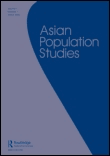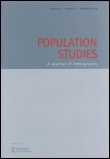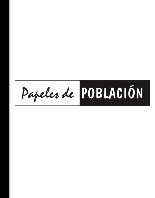
Asian Population Studies
Scope & Guideline
Illuminating the Complexities of Population Change
Introduction
Aims and Scopes
- Demographic Changes and Trends:
The journal extensively covers various demographic changes, such as fertility rates, migration patterns, and aging populations, providing analyses that inform policy and societal understanding. - Socioeconomic Influences on Population Dynamics:
Research often investigates how socioeconomic factors, including education, employment, and income levels, impact demographic behaviors and trends across Asian countries. - Gender Studies in Demography:
The journal highlights gendered aspects of demographic issues, including gender inequalities in labor, marriage, and family dynamics, contributing to a deeper understanding of societal structures. - Health and Well-being in Population Studies:
There is a strong focus on the intersection of demographic trends with health outcomes, particularly in relation to aging populations, mental health, and the effects of pandemics. - Cultural and Regional Variations:
The journal emphasizes the importance of cultural context in understanding demographic phenomena, showcasing research that reflects the diverse experiences of different Asian societies.
Trending and Emerging
- Impact of COVID-19 on Demographics:
There is a growing body of work examining how the COVID-19 pandemic has reshaped demographic trends, including fertility rates, migration patterns, and mental health outcomes. - Gender and Work-Life Balance:
Research focusing on gender roles, particularly in the context of work-life balance and domestic labor, is gaining prominence, reflecting societal changes in gender dynamics. - Aging Populations and Policy Responses:
The challenges posed by aging populations are increasingly becoming a focal point, with studies exploring policy responses and societal adaptations to support older adults. - Migration Dynamics in a Globalized World:
Emerging themes related to migration include the complexities of skilled migration, integration challenges, and the socio-economic impacts of migration on both sending and receiving countries. - Socioeconomic Disparities and Health Outcomes:
An increased emphasis on the relationship between socioeconomic status and health outcomes is evident, particularly in understanding disparities in health access and quality across different populations.
Declining or Waning
- Traditional Fertility Studies:
While fertility remains a key area of study, the prevalence of traditional fertility analyses has declined, with more emphasis now being placed on the socio-cultural factors influencing fertility decisions. - Static Migration Patterns:
Research on static migration patterns and traditional migration flows has decreased, as newer studies focus more on dynamic migration trends and the implications of temporary and circular migration. - Focus on Rural Demographics:
The examination of rural demographic issues has become less frequent, possibly overshadowed by urban-centric studies that address the rapid changes in urban populations and migration. - Historical Demographic Analysis:
There is a noticeable reduction in studies that focus on historical demographic trends, with a shift toward contemporary issues arising from recent events like the COVID-19 pandemic. - Elderly Care in Traditional Contexts:
Research on traditional elderly care practices is diminishing, as newer studies tend to address modern care challenges and the implications of aging in a rapidly changing demographic landscape.
Similar Journals

POPULATION STUDIES-A JOURNAL OF DEMOGRAPHY
Advancing Insights into Population TrendsPopulation Studies: A Journal of Demography is an esteemed scholarly publication dedicated to advancing the understanding of demographic trends and their historical contexts. Published by Routledge Journals, Taylor & Francis Ltd, this journal has a notable impact in its field, recognized as a Q1 category journal in both Demography and History as of 2023. Its Scopus rankings highlight its significance, featuring a remarkable 12th place rank in Arts and Humanities—History and 19th place in Social Sciences—Demography, both underscoring its influential role in academic research. Established in 1947, the journal has consistently contributed to the discourse in population studies, offering a platform for innovative research and critical analysis. While it does not provide open access options, it remains a vital resource for researchers, professionals, and students who seek to explore the complex relationships between population dynamics and historical narratives. Its comprehensive coverage from 1947 to 2024 ensures a rich repository of knowledge, making it essential for anyone involved in demographic research.

Journal of Demographic Economics
Unlocking the Potential of Population Trends for Economic GrowthThe Journal of Demographic Economics, published by Cambridge University Press, stands as a leading interdisciplinary platform dedicated to the exploration and advancement of research in the intertwined fields of demography, economics, and geography. With an impact factor that reflects its esteemed position—ranking in the Q1 quartile for Demography (2023)—the journal fosters scholarly dialogue through high-quality articles that elucidate the complex interactions between population dynamics and economic trends. Operating under an open access model, the journal ensures that its findings are widely accessible, promoting inclusivity and engagement among researchers, professionals, and students alike. The Journal of Demographic Economics endeavors to bridge gaps in knowledge by publishing innovative and rigorous studies, thereby contributing significantly to both theoretical frameworks and practical applications across various domains. Drawing submissions from a global audience, this journal not only enhances the understanding of demographic transitions but also informs policy decisions and socioeconomic development strategies, making it an essential resource for those invested in demographic and economic research.

JOURNAL OF BIOSOCIAL SCIENCE
Bridging Biology and Social Science for a Healthier FutureJOURNAL OF BIOSOCIAL SCIENCE, published by Cambridge University Press, is a pivotal interdisciplinary journal dedicated to advancing our understanding of the complex interplay between biological and social factors in human health and society. With an ISSN of 0021-9320 and an E-ISSN of 1469-7599, this journal has been a cornerstone of scholarly communication since its inception in 1969, paving the way for innovative research until 2024 and beyond. The journal is ranked in the Q3 quartile in Public Health, Environmental and Occupational Health and Q2 in Social Sciences (miscellaneous), reflecting its significant impact in these fields. Its Scopus ranking further emphasizes its relevance, sitting at #79 out of 275 in General Social Sciences and #334 out of 665 in Public Health. Researchers, professionals, and students are encouraged to explore the journal's rich repository of articles that delve into critical biosocial issues, fostering a deeper understanding of how social structures influence health and well-being. Although not open access, the journal remains an essential resource for those committed to addressing contemporary health challenges through a biosocial lens.

DEMOGRAPHY
Connecting research with real-world population challenges.DEMOGRAPHY is a prestigious, peer-reviewed journal published by DUKE UNIVERSITY PRESS, dedicated to advancing the field of demography through scholarly research and critical discourse. With an esteemed Q1 ranking in Social Sciences and an impressive Scopus rank of #10 out of 139 in the category, this journal holds a 93rd percentile status, reflecting its significant impact on the academic community. Covering a wide range of topics related to population studies, including fertility, mortality, migration, and demographic change, DEMOGRAPHY serves as a vital resource for researchers, professionals, and students alike. Since its inception in 1964, it has provided a platform for innovative studies and influential articles that address both theoretical frameworks and applied research. Although not an open-access journal, it ensures that its contributions reach a global audience while maintaining rigorous academic standards. Engage with DEMOGRAPHY to explore and contribute to the dynamic discussions shaping our understanding of human populations in a complex world.

Papeles de Poblacion
Unveiling the complexities of demographic change.Papeles de Población, published by the Universidad Autónoma del Estado de México, is a prominent open-access journal that has been advancing the field of demography since its inception in 1997. With an ISSN of 1405-7425, this journal aims to foster a deeper understanding of population studies through research articles, reviews, and critical analyses that address the complex dynamics of demographic changes, social structures, and their implications. While currently ranked in the fourth quartile of its category in 2023, it serves as a significant channel for researchers, professionals, and students to disseminate and access cutting-edge findings. Open access since 2004, it provides a platform for broader readership and knowledge sharing, thus contributing to the global discourse on population issues. Based in Mexico, the journal is committed to embracing diverse perspectives, emphasizing the importance of regional studies within a global context.

STUDIES IN FAMILY PLANNING
Empowering research for a sustainable future in demography.STUDIES IN FAMILY PLANNING, published by WILEY, is a renowned journal that serves as a critical resource in the fields of Demography and Social Sciences. With an impressive Q1 ranking in both categories, it is recognized for its high impact and influential contributions to the understanding of family planning dynamics, reproductive health, and population studies. The journal has published scholarly articles since 1970, reflecting its long-standing commitment to advancing knowledge and research in these important areas. Currently holding a rank of #27 out of 139 in Demography on Scopus, the journal's 2023 impact factor underscores its influential role in shaping policy and practice worldwide. Though it operates under a subscription model, it is readily accessible to members of the academic community, including researchers, professionals, and students dedicated to improving family planning systems and socio-demographic studies.

GENUS
Empowering Research for a Sustainable Future in DemographyGENUS is a prestigious open-access journal published by SpringerNature, dedicated to advancing research in the field of demography. With an E-ISSN of 2035-5556, it has been operating as an open-access platform since 2016, ensuring that valuable demographic knowledge is accessible to a global audience. Located in Switzerland, this journal contributes significantly to the scholarly community, achieving a remarkable Q1 ranking in the 2023 Scopus category for Social Sciences focusing on Demography, where it stands at an impressive Rank #12 out of 139, placing it in the 91st percentile. With a history that spans several decades, starting from 1970 and including comprehensive coverage from 2007 to 2024, GENUS provides a vital forum for researchers, professionals, and students seeking to engage deeply with current demographic studies. This journal not only publishes cutting-edge research but also facilitates fruitful discussions on key demographic trends and policies, making it an essential resource for anyone interested in the social sciences.

Demografie
Connecting scholars and practitioners in the realm of demography.Demografie is a distinguished academic journal published by the Cesky Statistical Office in the Czech Republic, serving as a vital platform for scholars and practitioners interested in the multifaceted field of demography. Established in 1976 and consistently contributing until 1999, with a renewed focus from 2014 to 2024, this journal engages with critical issues such as population dynamics, migration patterns, and socio-economic factors influencing demographic changes. For its impactful research contributions, it holds a Q3 category ranking in Demography for 2023, with a Scopus rank of #89 out of 139 in the Social Sciences category, reflecting its credibility and relevance in the field. Although it operates under traditional access, its insightful articles and comprehensive analyses remain valuable resources for researchers, professionals, and students eager to deepen their understanding of demographic trends and policies. The journal's commitment to advancing demographic knowledge makes it an essential read for those navigating the complexities of population studies.

Demographic Research
Exploring the trends that shape our societies.Demographic Research is a leading journal in the field of demography, published by the prestigious Max Planck Institute for Demographic Research. Available in both print and electronic formats (ISSN: 1435-9871, E-ISSN: 1435-9871), this open-access journal has been a valuable resource for demographers and social scientists since its inception in 1999. With a commendable impact factor and ranked Q1 in its category, the journal demonstrates a significant commitment to advancing our understanding of demographic trends and their implications across contexts. Hailing from Germany, the journal's rich international perspective adds depth to its studies, making it a vital platform for innovative research. Researchers, professionals, and students are encouraged to engage with its wealth of articles that not only document demographic changes but also offer insights critical for policy-making and social planning. The journal's broad scope encompasses diverse themes, providing a comprehensive overview of the demographic shifts that shape societies today.

JOURNAL OF POPULATION ECONOMICS
Connecting Population Studies with Economic AnalysisThe JOURNAL OF POPULATION ECONOMICS, published by SPRINGER, stands as a leading peer-reviewed journal in the fields of demography and economics. Established in 1988, this esteemed journal offers a platform for high-quality research that probes the intricate relationships between population dynamics and economic phenomena. With its impressive Q1 quartile ranking in both Demography and Economics and Econometrics for 2023, the journal is recognized as a vital resource for scholars and practitioners alike, reflecting its rigorous standards and impact in the academic community. Its Scopus rankings position it within the top tiers of social sciences, making it an essential read for those engaged in demographic and economic research. Although the journal does not currently adopt an open access model, its esteemed reputation and continuous publication until 2024 ensure relevant and up-to-date findings contribute meaningfully to scholarly discourse. At its core, the JOURNAL OF POPULATION ECONOMICS aims to bridge theoretical insights and empirical findings, fostering an understanding of how population changes influence economic outcomes and vice versa.